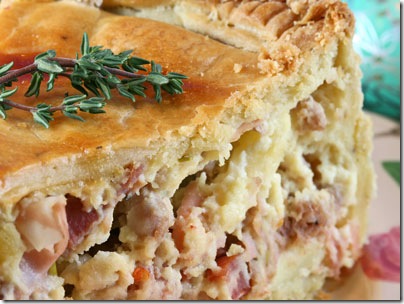[vc_row][vc_column][vc_column_text]Growing up in an Italian Catholic family was all about family, food, and tradition. One great tradition was making the Easter Pie. During the Lenten season, we all fasted, especially on Good Friday (no meat) and on Holy Saturday. When it came to Easter Sunday, we splurged.
I can remember the smells on the Saturday before Easter, when Mickalene was frying off the sausage, making the crust, then baking the pies. We couldn’t wait until we dug into the cheesy, meaty, dense delight – but it was reserved for Easter Sunday morning. The dish was incredibly labor intensive, and my Mom make enough to feed a small army.
There are many varieties of the “Easter Pie,” based on the regional Italian cooking. It’s called Pizzagaina, pizza piena (stuffed pizza), pastiera in the Naples, pizzachino, pizza rustica, but we called it Torta Pasqualina (which is simply Easter Pie). For the most part, it is a quiche-like savory pie, but I have also seen some sweet versions. The basics of the savory version call for eggs, cheese, meat, often a green vegetable (we used spinach, our Tyrolean parts of the family used asparagus, and we’ve seen others use swiss chard). My Mom’s father came from Abruzzo, and my Dad’s family came from Calabria, so our version is a mix of both: sweet sausage, ham, spinach, and a lot of other goodies. Try this version that Mickalene made – and perfected through many years of hard work.
[/vc_column_text][vc_separator color=”grey” align=”align_center”][vc_column_text]Ingredients – Dough
6 cups all purpose flour
2 teaspoons coarse salt
1/4 teaspoon baking powder
5 tablespoons olive oil
1-1/2 cups (about) cold water
To mix the dough by hand, combine flour, salt and baking powder in a medium-sized mixing bowl and stir well to mix. Slowly add the olive oil while cutting with a pastry blender.
Sprinkle the minimum amount of water over the flour mixture and stir gently with a fork — the dough should begin holding together. If the mixture still appears dry and crumbly, add more water, a tablespoon at a time, until the dough holds together easily. It should be a fairly stiff dough. Turn dough out onto lightly floured surface and knead until smooth and elastic, about 15 minutes (you can also do this in a stand mixer with the dough hook). Cover with inverted bowl and let stand 30 minutes. Alternatively, wrap and refrigerate the dough until firm, or until you are ready to use it, at least 1 hour, or up to several days (it is VERY important to let the dough rest).
To mix the dough in the food processor, combine flour, salt and baking powder in work bowl fitted with metal blade. Pulse 3 times at 1-second intervals to mix. Add oil to work bowl. Process, pulsing repeatedly at 1-second intervals, until the mixture is fine and powdery, — about 15 pulses in all. Scatter the minimum amount of water on the butter and flour mixture and pulse 5 or 6 times — the dough should begin holding together. If the mixture still appears dry and crumbly, add the remaining water, a tablespoon at a time, until the dough holds together easily.
Ingredients – Filling
- 8 ounces sweet Italian sausage
- 1 pound cooked spinach, chopped
- 1 medium sweet onion, finely chopped
- 1/2 pound cooked ham, cut into 1/4 inch pieces (alternatively, 4 ounces hard salami, chopped, and 4 ounces prosciutto, chopped)
- 1 pound fresh basket cheese, drained and cut into 1/4 inch pieces (NOTE: This is sometimes hard to find. You can use fontina, or the toma from Piedmont. Or, you can use more mozzarella, cut up into 1/4 pieces).
- 1 pound ricotta cheese, drained
- 4 ounces mozzarella cheese, shredded (about 1 cup)
- ¼ grated Parmesan cheese
- 3 eggs, lightly beaten with a fork
- Three hard boiled eggs, sliced
- 1 egg, beaten, and 1 teaspoon water, for the egg wash
Preheat oven to 350 degrees F.
Brown the sausage over medium heat in a large sauté pan, breaking it up into bite-size pieces as it cooks. Cook until the sausage is no longer pink in the middle, adding the onions during the last few minutes of cooking. Using a slotted spoon, transfer the sausage and onions to a large mixing bowl. Allow to cool.
Add all the remaining ingredients except the hard boiled eggs, and mix well until thoroughly combined.
Prepare two 8 inch square glass or ceramic baking dishes, with at least 2 inch side – grease and flour each thoroughly (you can use a 9 inch deep dish pie plate). Turn the dough out onto a lightly floured surface, cut into four portions, then form each portion into a disk. Roll out one disk for each baking dish about ⅛-inch thick. Transfer the dough to the prepared baking dishes.
Transfer the filling to the dough-lined pie plate. There is a lot of filling, so you’ll want to pack it tightly into the pie dish, mounding it slightly in the center. Place the sliced hard boiled eggs over the top.
Roll out the other dough round and place over the filling. Trim top and bottom edges to ½ inch beyond pan lip. Tuck this rim of dough underneath itself so that folded edge is flush with pan lip. Flute edging or press with fork tines to seal. Cut four slits at right angles on dough top.
Brush the egg wash over the top crust of the pie.
Bake the pie until the crust is golden brown and the cheese is bubbling through the slits on top, about 50 minutes. Let the pie sit for at least 30 minutes before serving. Any leftovers should be refrigerated.[/vc_column_text][vc_column_text]One final note: there are a number of recipes and YouTube videos on making Italian Easter pie. A few use phyllo dough, which is an acceptable cheat. If you want to see a really brilliant version, check out this YouTube video, which has a unique approach to the dough: https://www.youtube.com/watch?v=j0hyf7kexfY[/vc_column_text][/vc_column][/vc_row]



